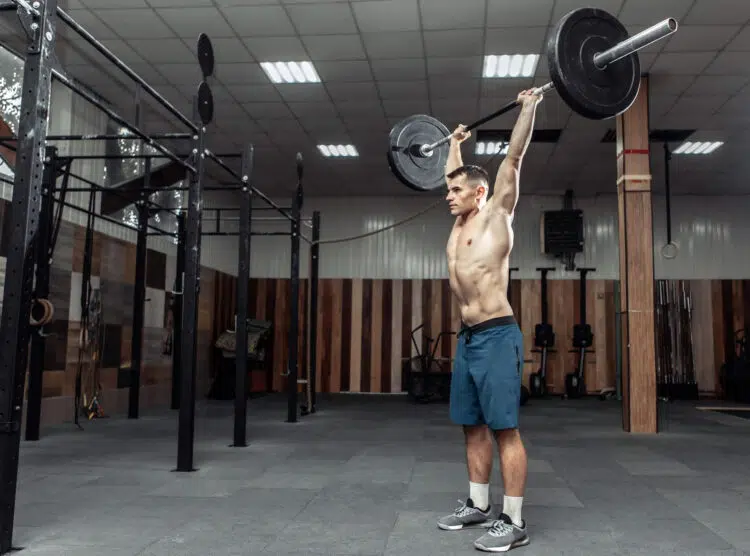Most strength training exercises are static. You do them seated or standing, only moving your arms or legs. While this is an effective way to emphasize specific muscle groups, it’s not an especially functional way to train.
That’s because most real-world physical challenges involve your arms AND legs working together. For example, lifting a heavy object from the floor and placing it on a high shelf.
However, arguably the greatest strength challenge that most people face involves lifting and then carrying a heavy load. This might be picking up your child to put them in the car or taking out the garbage.
Most contact sports also involve an element of lifting and carrying heavy loads – often a member of the opposing team. Consequently, many athletes use functional training to enhance their sports performance and potentially lower their risk of injury (1).
As a veteran personal trainer, I recognize the importance of training my clients for the challenges they face outside of the gym. There is no point in being the king of the gym if you can’t use that strength out in the real world.

Level Up Your Fitness: Join our 💪 strong community in Fitness Volt Newsletter. Get daily inspiration, expert-backed workouts, nutrition tips, the latest in strength sports, and the support you need to reach your goals. Subscribe for free!
In my opinion, weighted carries are one of the most effective ways to build functional strength. Subsequently, I include weighted carries in many of my client’s workouts.
In this article, I share one of my favorite carrying exercises – the barbell overhead carry – explaining how and why to do it. I also provide several variations and alternatives you can use to keep your workouts fresh and interesting.
Barbell Overhead Carry Correct Form
The barbell overhead carry is a relatively straightforward exercise, but that doesn’t mean your form doesn’t matter. Follow these step-by-step instructions to ensure that every set of overhead carries you do is as safe and effective as possible:
- Hold a barbell with an overhand, slightly wider than shoulder-width grip.
- Pull your shoulders down and back and brace your core.
- Lift the bar overhead so it’s directly over your feet. Your arms should be straight and vertical.
- Keeping your core, shoulders, and upper back engaged, go for a slow walk around your training area. Do not let the weight fall forward or backward at any time.
- Continue for the prescribed duration or distance.
- Carefully lower the barbell to the floor, rest a moment, and repeat.
Barbell Overhead Carry: Muscles Worked
While most exercises can be classified as upper or lower-body movements, the barbell overhead carry is more of a full-body exercise. As such, it involves a long list of muscles – pretty much all 600+ in the human body! That said, the following is a list of the main “movers and shakers” trained by this distinctive exercise:
- Deltoids (anterior, medial, posterior)
- Trapezius
- Rhomboids
- Triceps
- Core (rectus abdominis, obliques, transverse abdominis, erector spinae)
- Gluteus maximus, medius, and minimus
- Hamstrings
- Quadriceps
- Gastrocnemius and soleus
Pro-Trainer Tips
Get more from the barbell overhead carry with these tried-and-tested pro-trainer tips:
Master the Power Clean and Push-Press First!
Getting the bar up above your head so you can take it for a walk means doing a power clean followed by a push-press or jerk. Therefore, make sure you can perform both these movements proficiently before adding barbell overhead carries to your program.
Use an Appropriate Load
While you can eventually work up to using some impressively heavy loads with this exercise, I suggest starting with a weight that’s roughly 50% of your strict press one-repetition maximum (1RM). This should be heavy enough to be challenging but not so heavy you are unable to maintain good form throughout your set.
Make Sure Your Training Area is Unobstructed
Carrying a loaded barbell overhead around a cluttered or hectic gym is a recipe for disaster. Only do this exercise if it’s safe to do so, i.e., there are no obstructions or other exercisers in your way. Overhead barbell carries are not suitable for busy, crowded gyms.
Keep Your Core Braced Throughout
While you’ll probably feel this exercise mostly in your upper body, rest assured that your core is getting a great workout, too. In fact, you’ll have to actively use your core muscles to stabilize your spine and maintain an upright torso. Brace from the start of your set to the finish to avoid back injuries caused by poor lumbar posture.
Chalk Your Hands
Holding a heavy barbell overhead while walking around your gym will make anyone’s palms sweat. Needless to say, slippery hands are the last thing you’ll want with a weight held above your head. Avoid sweaty palms by dusting your hands with gym chalk before every set.
Barbell Overhead Carry Mistakes to Avoid
Make barbell overhead carriesas safe as possible by avoiding these common mistakes.
Allowing the Barbell to Move Forward/Backward
While you should have no problem controlling a light to moderate weight, you’ll soon lose control of a heavy barbell if you allow it to fall forward or backward. Forward will bring a premature end to your set, while backward could severely injure your shoulders. Keep your arms vertical and the weight over your feet at all times.
Using an Unevenly Loaded Barbell
Walking with a barbell held overhead means you’ll have to work hard to stabilize the weight. Don’t make things harder by training with an unevenly loaded barbell. Make sure you have the same weight on both ends and that you grip the bar symmetrically. Use the rings on the bar to check that your hand position is correct.
Not Actively Engaging Your Shoulders and Upper Back
As well as bracing your core, you must “brace” your shoulder girdle (scapulae/clavicles) to stabilize your shoulders and upper back. This involves actively pulling your shoulders down and back and then pressing the palms of your hands upward against the weight. Passive shoulders are more prone to injury. Practice this technique by mastering overhead shrugs.
Level Up Your Fitness: Join our 💪 strong community in Fitness Volt Newsletter. Get daily inspiration, expert-backed workouts, nutrition tips, the latest in strength sports, and the support you need to reach your goals. Subscribe for free!
Hyperextending Your Lower Back
A lot of people hyperextend (over arch) their lower back when they raise their arms above their head. This is usually because they have tight pecs or lats, immobile shoulders, or a weak core. Overarching puts a lot of stress on your lower back and is best avoided. If you cannot do barbell overhead carries without hyperextending, you should avoid this exercise.
Walking Too Fast
It’s only natural to do challenging exercises quickly. After all, going slow merely prolongs your agony. However, walking too fast during barbell overhead carries increases the chances that you’ll lose control of the weight. It also makes the exercise less effective. If you feel the need to speed up, what you probably need to do is reduce the weight.
Barbell Overhead Carry Benefits
Not sure if barbell overhead carries deserve a place in your workouts? Consider these benefits and then decide.
A Highly Functional Exercise
Lifting and then carrying a heavy object is the epitome of functional training. It’s something that many people have to do on a daily basis. Kids, groceries, pets, gardening equipment – you get the idea! So, forget doing squats on a BOSU or uphill lunges; the barbell overhead carry is REAL functional strength training.
A Challenging Core Exercise
Exercises that feature long levers tend to develop stability better than those with short levers. Holding a weight at arm’s length above your head means the load is a long way from your core, which will have to work very hard to stabilize your spine. Consequently, the barbell overhead carry is an excellent core-strengthening exercise.
Good for Improving Shoulder Stability
The shoulder is the most mobile but least stable joint of the body. As such, the shoulder joint is prone to injury and pain. That’s why so many Fitness Volt guides include the cue, “pull your shoulders down and back.” This action increases shoulder stability. The overhead carry also develops shoulder stability, making your joints even more resilient.
Useful for Adding Variety to Your Workouts
Are you bored of doing the same old shoulder presses, triceps extensions, and planks? Breathe new life into your workouts with overhead carries! This exercise is challenging, unique, and fun, and works multiple muscle groups simultaneously. My army of personal training clients love this exercise and if you try it, I think you will too.
Adaptable for All Levels
Because the barbell overhead carry is such a straightforward exercise, almost all levels of exerciser can do it. Simply adjust the load to make it as easy or as challenging as you need. There are also several ways to make it even better for more advanced exercisers, such as walking in a zigzag, stepping over obstacles, or walking sideways/backward.
Barbell Overhead Carry Variations
While I’m a massive fan of the barbell overhead carry, I recognize that doing the same exercise over and over can become boring, and some people may prefer something different. So, here are five variations and alternatives to try:
Dumbbell Overhead Carry
Carrying dumbbells overhead is more challenging than a barbell as you’ll have to work harder to stabilize your shoulders. In addition, using dumbbells allows you to use a neutral grip, which many lifters find more comfortable. Either way, dumbbell overhead carries are a useful exercise that deserves a place in your workouts.
Single-Arm Waiter’s Walk
Barbell overhead carries are a great core exercise, but you can increase core and especially oblique engagement by using just one dumbbell or kettlebell. The uneven load will force you to brace even harder as you work to keep your torso upright. Additionally, getting one weight into position is usually easier than clean and pressing a barbell.
Zercher Carry
Are you nervous about holding a barbell over your head? Ease your anxiety with the Zercher carry. This exercise involves holding a barbell in the crooks of your elbows, where there is no danger of dropping it on your head. This exercise emphasizes your posterior core, i.e., your lower back. You’ll also feel it in your glutes and hamstrings more.
Sandbag Bearhug Carry
Sandbags are a great option for functional strength training. The contents of the bag constantly shift, forcing you to adjust your grip. Compared to lifting and carrying a barbell, a sandbag is like wrestling a sack full of snakes! The sandbag bearhug carry works the same muscles as the Zercher carry but is a lot more comfortable for your elbows.
Farmer’s Walk
The farmer’s walk is the exercise that started the weighted carry trend. Simple yet effective, this exercise will increase your core, grip, and upper back strength. Just grab a couple of dumbbells, hold them down by your side, and go for a walk. Alternatively, lift and carry just one weight to work your obliques more.
Related: Weighted Carries for Strength and Size
Closing Thoughts
The barbell overhead carry is a uniquely challenging exercise. Working many major muscles, it will beef up your shoulders and triceps while sculpting a core of iron. It’s also a very functional exercise that transfers well to activities outside of the gym.
On the downside, you’ll need plenty of space to do this exercise, and it’s essential to master the barbell clean and press before attempting it.
However, if you can overcome these obstacles, you will be rewarded. The barbell overhead carry is one of my favorite functional core, strength, and stability exercises, and my personal training clients are always happy to see it in their programs.
So, try this exercise for yourself or use one of the variations/alternatives listed elsewhere in this article. While you’re going to raise a few eyebrows at the gym, the results will quickly convince you how effective this exercise is.
References:
- Wang X, Soh KG, Samsudin S, Deng N, Liu X, Zhao Y, Akbar S. Effects of high-intensity functional training on physical fitness and sport-specific performance among the athletes: A systematic review with meta-analysis. PLoS One. 2023 Dec 8;18(12):e0295531. doi: 10.1371/journal.pone.0295531. Erratum in: PLoS One. 2024 Feb 16;19(2):e0299281. doi: 10.1371/journal.pone.0299281. PMID: 38064433; PMCID: PMC10707569.
Interested in measuring your progress? Check out our strength standards for Clean and Press, Push Press, Clean, and more.








